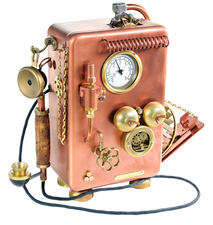Overview of the Serial Communication Protocol
In Series

© Lead Image © 3355m, 123RF.com
We explore serial communications, from the electrical specs to protocols and libraries, with an example of serial communication with an Arduino.
The word "serial" in terms of computers might bring several things to mind. In modern times, it might be the universal serial bus (USB). Not too long ago, it might have brought to mind a 9-pin connector on the back of your desktop – or the even bigger 25-pin connector a bit before that. Different, still, the term might bring up memories of modems, printers, or peripherals connected to specialty computers. If you look at early mainframes, the serial port was the main interface to a text terminal and thus the human interface to the computer.
Some of these usages have been superseded by newer or different technologies, but serial is still alive and well. Although not as common on today's computer equipment, serial communication is far from gone, and its availability can provide some interesting possibilities for talking to unique hardware.
Basic Principles
In the simplest sense, an electric circuit used for communication just uses a completed circuit to represent a 1 and a broken circuit to represent a 0. See the "Telegraphy" sidebar for how this worked in real life for years. The limitation of a simple telegraphy circuit is that for each signal you want to send, you need a dedicated wire.
[...]
Buy Linux Magazine
Subscribe to our Linux Newsletters
Find Linux and Open Source Jobs
Subscribe to our ADMIN Newsletters
Support Our Work
Linux Magazine content is made possible with support from readers like you. Please consider contributing when you’ve found an article to be beneficial.

News
-
Mozilla Plans to AI-ify Firefox
With a new CEO in control, Mozilla is doubling down on a strategy of trust, all the while leaning into AI.
-
Gnome Says No to AI-Generated Extensions
If you're a developer wanting to create a new Gnome extension, you'd best set aside that AI code generator, because the extension team will have none of that.
-
Parrot OS Switches to KDE Plasma Desktop
Yet another distro is making the move to the KDE Plasma desktop.
-
TUXEDO Announces Gemini 17
TUXEDO Computers has released the fourth generation of its Gemini laptop with plenty of updates.
-
Two New Distros Adopt Enlightenment
MX Moksha and AV Linux 25 join ranks with Bodhi Linux and embrace the Enlightenment desktop.
-
Solus Linux 4.8 Removes Python 2
Solus Linux 4.8 has been released with the latest Linux kernel, updated desktops, and a key removal.
-
Zorin OS 18 Hits over a Million Downloads
If you doubt Linux isn't gaining popularity, you only have to look at Zorin OS's download numbers.
-
TUXEDO Computers Scraps Snapdragon X1E-Based Laptop
Due to issues with a Snapdragon CPU, TUXEDO Computers has cancelled its plans to release a laptop based on this elite hardware.
-
Debian Unleashes Debian Libre Live
Debian Libre Live keeps your machine free of proprietary software.
-
Valve Announces Pending Release of Steam Machine
Shout it to the heavens: Steam Machine, powered by Linux, is set to arrive in 2026.

